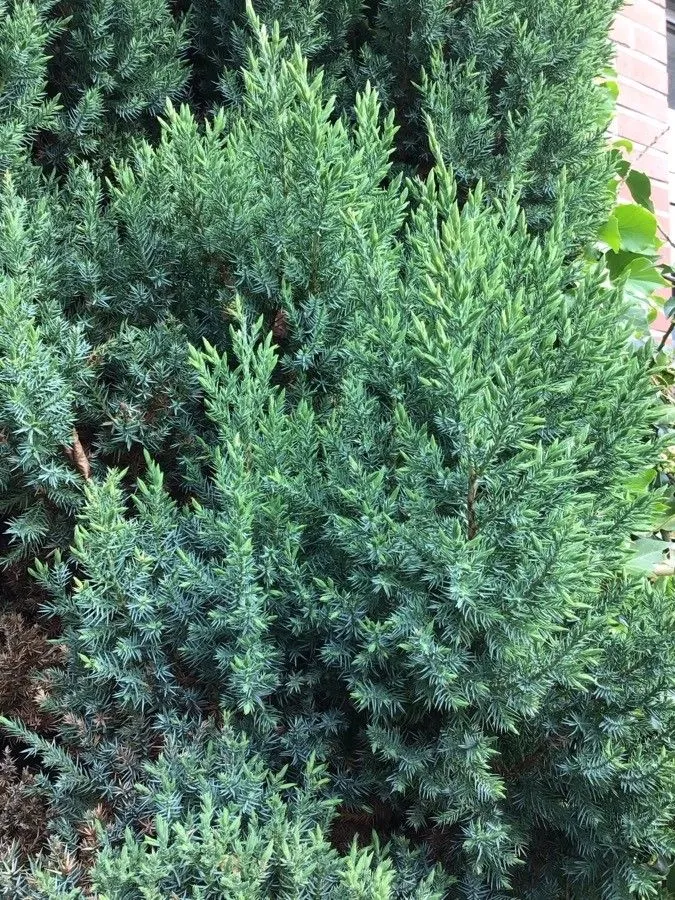
Author: L.
Bibliography: Mant. Pl.: 127 (1767)
Year: 1767
Status: accepted
Rank: species
Genus: Juniperus
Vegetable: False
Observations: Russian Far East to N. Myanmar and Temp. E. Asia
The Chinese juniper, scientifically known as Juniperus chinensis, is an evergreen conifer celebrated for its versatility and aesthetic appeal in horticulture and landscaping. This species was first documented in the seminal work “Mantissa Plantarum” in 1767 by the renowned botanist Carl Linnaeus, hence the abbreviated author citation “L.”
Native to a broad geographical range, the Chinese juniper thrives from the Russian Far East to northern Myanmar and throughout temperate regions of East Asia. This wide adaptability makes it a resilient and popular choice for various environmental conditions.
Juniperus chinensis belongs to the Cupressaceae family, a lineage known for its diverse and ecologically significant coniferous trees and shrubs. Its robust nature supports various forms, from low-growing ground covers to majestic, upright trees. This diversity is particularly appreciated in ornamental gardening, where different cultivars of Chinese juniper serve as groundcover, hedges, or striking specimen plants.
The foliage of the Chinese juniper can vary in color from vibrant green to blue-green, often accompanied by a pleasant fragrance, adding an extra sensory dimension to its visual appeal. The plant also produces small berry-like cones, which change color from green to a rich, mature blue, providing food for wildlife and subtle seasonal interest in a garden setting.
Adaptable to different soil types and tolerant of urban pollution, the Chinese juniper is a resilient addition to both private gardens and public green spaces. Its ability to withstand pruning makes it an excellent candidate for topiary, bonsai, and other forms of landscape artistry. In addition to its ornamental virtues, the Chinese juniper is also valued for its practical applications in erosion control due to its extensive root system.
In summary, the Chinese juniper (Juniperus chinensis) is a versatile and robust plant that enhances both natural and landscaped environments through its varied forms, appealing foliage, and ecological benefits. Native to a vast expanse of East Asia, it continues to be a favored choice for gardeners and landscapers around the world.
Dan: almindelig pimpinelle, kinesisk ene, mesterrod, persille, stor pimpinelle
Swe: bockrot, mästerrot, persilja, stor bockrot, kinesisk en
Deu: china-wacholder, chinesische wacholder, chinesischer sadebaum
Nld: chinese jeneverbes
Eng: chinese juniper, chinese pyramid juniper
Nor: gjeldkarve, meisterrot, persille, stor gjeldkarve
Fin: isopukinjuuri, persilja, pukinjuuri
Hun: kínai boróka
Por: cipreste-grisalho, cipreste-variegado, junípero, junípero-chinês, junípero-chinês-rasteiro, junípero-kaizuka, pinheiro-kaizuka, zimbro, zimbro-chinês
Fra: genévrier de chine
Ces: jalovec cínský
Spa: sabina de china, sabina de jardín
Rus: можжевельник китайский плакучий (mozhzhevel’nik kitajskij plakuchij)
Zho: 圆柏 (yuan bai), yuan bai
Jpn: byakushin, ibuki, ibuki-byakushin, kamakura-byakushin
Kor: kong nam tsong
En: Chinese juniper, Chinese pyramid juniper
Ar: عرعر صيني
Az: Çin ardıcı
Bg: Китайска хвойна
Ca: Ginebre xinès
Zh: Yuan bai, 圆柏, 桧树, 圆柏 (yuan bai)
Cs: Jalovec čínský, Jalovec cínský
Da: Almindelig Pimpinelle, Kinesisk ene, Mesterrod, Persille, Stor Pimpinelle
Nl: Chinese jeneverbes
Et: Hiina kadakas
Fi: Kiinankataja, Isopukinjuuri, Persilja, Pukinjuuri
Fr: Genévrier de Chine
Gl: Sabina de xardín
De: Chinesischer Wacholder, China-Wacholder, Chinesische Wacholder, Chinesischer Sadebaum
Hu: Kínai boróka
Is: Kínaeinir
Ja: Ibuki, Ibuki-byakushin, Kamakura-byakushin, Byakushin
Ko: Hyangnamu, 향나무, Kong Nam Tsong
No: Kinesisk einer, Gjeldkarve, Meisterrot, Persille, Stor gjeldkarve
Fa: جونیپروس چیننسیس
Pl: Jałowiec chiński
Pt: Cipreste-grisalho, Cipreste-variegado, Junípero, Junípero-chinês, Junípero-chinês-rasteiro, Junípero-kaizuka, Pinheiro-kaizuka, Zimbro, Zimbro-chinês
Ru: Можжевельник китайский, Можжевельник китайский плакучий (mozhzhevel’nik kitajskij plakuchij)
Sk: Borievka čínska
Es: Sabina de China, Sabina de jardín, Enebro
Sv: Kinesisk en, Bockrot, Mästerrot, Persilja, Stor bockrot
Zh-tw: 檜樹
Th: สนมังกร
Zh-hant: 檜樹
Taken Apr 15, 2019 by Karl Heinz Trimborn (cc-by-sa)
Taken Apr 15, 2019 by Karl Heinz Trimborn (cc-by-sa)
Taken Dec 14, 2021 by Rubens Curvelo (cc-by-sa)
Taken Jan 17, 2022 by witt1 (cc-by-sa)
Taken Jan 17, 2022 by witt1 (cc-by-sa)
Taken Sep 4, 2022 by Dieter Albrecht (cc-by-sa)
Taken Sep 10, 2022 by NathaN Del (cc-by-sa)
Taken Jan 18, 2021 by FERREIRA DIEGO CÉSAR (cc-by-sa)
Taken Oct 20, 2017 by Dieter Albrecht (cc-by-sa)
Taken Mar 17, 2003 by Daniel Barthelemy (cc-by-sa)
© copyright of the Board of Trustees of the Royal Botanic Gardens, Kew.
© copyright of the Board of Trustees of the Royal Botanic Gardens, Kew.
© copyright of the Board of Trustees of the Royal Botanic Gardens, Kew.
Taken Oct 17, 2003 by Daniel Barthelemy (cc-by-nc)
Taken Oct 17, 2003 by Daniel Barthelemy (cc-by-nc)
Taken Mar 17, 2003 by Daniel Barthelemy (cc-by-sa)
Taken Oct 17, 2003 by Daniel Barthelemy (cc-by-nc)
Taken Oct 17, 2003 by Daniel Barthelemy (cc-by-nc)
Taken Mar 17, 2003 by Daniel Barthelemy (cc-by-sa)
Taken Mar 17, 2003 by Daniel Barthelemy (cc-by-sa)
Taken May 10, 2021 by Qurbanzada Shabnam (cc-by-sa)
Taken Oct 20, 2017 by Dieter Albrecht (cc-by-sa)
Taken Oct 4, 2021 by aigle maman (cc-by-sa)
Taken Mar 17, 2003 by Daniel Barthelemy (cc-by-sa)
Taken Dec 1, 2021 by Jamilly Geik (cc-by-sa)
Taken Jan 11, 2021 by Anne Valéry (cc-by-sa)
Taken Feb 26, 2022 by Ha Anna (cc-by-sa)
Taken Jan 26, 2022 by Maarten Vanhove (cc-by-sa)
Growth form>: Multiple Stem
Growth habit>: Tree, Shrub
Growth rate>: Rapid
Ph maximum: 7.5
Ph minimum: 4.5
Family: Myrtaceae Author: (F.Muell.) K.D.Hill & L.A.S.Johnson Bibliography: Telopea 6: 402 (1995) Year: 1995 Status:…
Family: Rubiaceae Author: Pierre ex A.Froehner Bibliography: Notizbl. Bot. Gart. Berlin-Dahlem 1: 237 (1897) Year:…
Family: Sapindaceae Author: Koidz. Bibliography: J. Coll. Sci. Imp. Univ. Tokyo 32(1): 38 (1911) Year:…
Family: Asteraceae Author: A.Gray Bibliography: Pacif. Railr. Rep.: 107 (1857) Year: 1857 Status: accepted Rank:…
Family: Fabaceae Author: Medik. Bibliography: Vorles. Churpfälz. Phys.-Ökon. Ges. 2: 398 (1787) Year: 1787 Status:…
Family: Aspleniaceae Author: (Cav.) Alston Bibliography: Bull. Misc. Inform. Kew 1932: 309 (1932) Year: 1932…